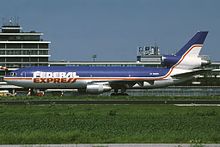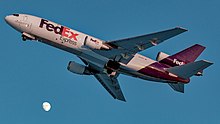
Memphis International Airport is a civil-military airport located seven miles (11 km) southeast of Downtown Memphis in Shelby County, Tennessee, United States. It is the primary international airport serving Memphis. It covers 3,900 acres (1,600 ha) and has four runways.

Delta Air Lines Flight 1141 was a scheduled domestic passenger flight between Dallas/Fort Worth, Texas and Salt Lake City, Utah. On August 31, 1988, the flight, using a Boeing 727-200 series aircraft, crashed during takeoff, resulting in 14 deaths and 76 injuries of the 108 on board.

American Airlines Flight 1420 was a flight from Dallas/Fort Worth International Airport (DFW) to Little Rock National Airport in the United States. On June 1, 1999, the McDonnell Douglas MD-82 operating as Flight 1420 overran the runway upon landing in Little Rock and crashed. 9 of the 145 people aboard were immediately killed—the captain and 8 passengers.

Pacific Southwest Airlines Flight 1771 was a scheduled flight along the West Coast of the United States, from Los Angeles, California, to San Francisco. On December 7, 1987, the British Aerospace 146-200A, registration N350PS, crashed in San Luis Obispo County near Cayucos, after being hijacked by a passenger.
This is a list of aviation-related events from 1994.

Air Canada Flight 797 was an international passenger flight operating from Dallas/Fort Worth International Airport to Montréal–Dorval International Airport, with an intermediate stop at Toronto Pearson International Airport.

On August 16, 1987 a McDonnell Douglas MD-82, operating as Northwest Airlines Flight 255, crashed shortly after takeoff from Detroit Metropolitan Airport, about 8:46 pm EDT, resulting in the deaths of all six crew members and 148 of the 149 passengers, along with two people on the ground. The sole survivor was a 4-year-old girl who sustained serious injuries. It was the second-deadliest aviation accident at the time in the United States. It is also the deadliest aviation accident to have a sole survivor, the deadliest plane crash in the history of the state of Michigan, and the worst crash in the history of Northwest Airlines.

Chattanooga Metropolitan Airport is 5 miles (8 km) east of downtown Chattanooga, in Hamilton County, Tennessee, United States. The airport is owned and operated by the Chattanooga Metropolitan Airport Authority. It is a Class C airport serviced by the Chattanooga Airport Traffic Control Tower. The Federal Aviation Administration (FAA) National Plan of Integrated Airport Systems for 2019–2023 categorized it as a small-hub primary commercial service facility.
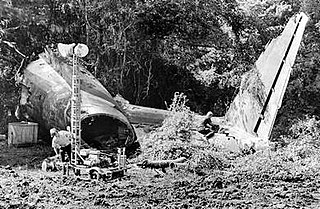
Eastern Air Lines Flight 212 was a controlled flight into terrain accident of a McDonnell Douglas DC-9 during approach to Charlotte Douglas International Airport in North Carolina. The incident occurred on September 11, 1974, killing 72 of the 82 people on board. The scheduled flight was from Charleston Municipal Airport to Chicago O'Hare, with an intermediate stop in Charlotte.

FedEx Express Flight 647 was a flight between Metropolitan Oakland International Airport (OAK), Oakland, California and Memphis International Airport (MEM), Memphis, Tennessee that crashed during landing on December 18, 2003.

Delta Air Lines Flight 723 was a flight operated by a McDonnell Douglas DC-9 twin-engine jetliner, operating as a scheduled domestic passenger flight from Burlington, Vermont, to Logan International Airport in Boston, Massachusetts, with an intermediate stop in Manchester, New Hampshire. On July 31, 1973, at 11:08 a.m., while on an instrument landing system (ILS) instrument approach into Logan in low clouds and fog, the aircraft descended below the glidepath, struck a seawall, and crashed. 88 of the 89 occupants aboard were killed.
Deadheading is the practice of carrying, free of charge, a transport company's own staff on a normal passenger trip so that they can be in the right place to begin their duties. In United States railway usage, the term may also be used for movement of train crews to or from a train using another means of vehicular transportation, as passenger train service is infrequent or nonexistent in many areas.

American Airlines Flight 383 was a scheduled passenger flight from O'Hare International Airport in Chicago, Illinois to Miami International Airport. On October 28, 2016, the Boeing 767-300ER operating the flight suffered an engine fire during takeoff. The crew aborted their takeoff, evacuating everyone on board, of whom 21 were injured. The plane was a write-off.
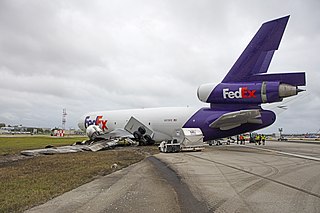
On October 28, 2016, FedEx Express Flight 910, a McDonnell Douglas MD-10-10F flying from Memphis International Airport to Fort Lauderdale–Hollywood International Airport was involved in a runway skid after a landing gear collapse, which resulted in a fire completely destroying the left engine and wing. Two crew members, the only people on board, were unharmed.

FedEx Express Flight 1406 was an American domestic cargo flight from Memphis International Airport, Memphis, Tennessee, to Logan International Airport in Boston, Massachusetts, that suffered an in-flight cargo fire over New York on September 5, 1996. The three crew members and two passengers on board successfully evacuated after an emergency landing at Stewart International Airport in Newburgh, New York. After the evacuation, the DC-10 was consumed by fire. After an extensive investigation, the National Transportation Safety Board was unable to determine what caused the fire. Nevertheless, the Federal Aviation Administration made recommendations to prevent similar incidents from occurring in the future.

Scandinavian Airlines System Flight 901, was a scheduled international flight operated by the Scandinavian Airlines System, that overran the runway at its destination at John F. Kennedy International Airport on February 28, 1984. The flight, using a McDonnell Douglas DC-10, originated at Stockholm Arlanda Airport, Sweden, before a stopover at Oslo Airport, Gardermoen, Norway. All 177 passengers and crew members on board survived, although 12 were injured. The runway overshoot was due to the crew's failure to monitor their airspeed and overreliance on the aircraft's autothrottle.
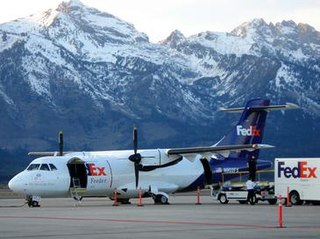
Empire Airlines Flight 8284 was a cargo flight operated by Empire Airlines for FedEx Feeder from Fort Worth Alliance Airport to Lubbock Preston Smith International Airport, Texas. On January 27, 2009, it crashed on final approach to its destination. Both crew members survived with minor injuries but the aircraft was written off.

Evergreen International Airlines Flight 17 (4U17/EIA17) was a cargo flight operated by Evergreen International Airlines and flown by a McDonnell Douglas DC-9. On March 18, 1989, the flight's planned route was scheduled to take it from Kelly Air Force Base to Tinker Air Force Base, with a stop at Carswell Air Force Base in Fort Worth, Texas. The two pilots were the only occupants on board. Immediately after takeoff from Carswell, the aircraft's main cargo door opened, the crew lost control of the aircraft and it subsequently crashed while attempting an emergency landing, killing both pilots.

Air Transport International Flight 782 was a ferry flight from Kansas City International Airport in Missouri to Westover Metropolitan Airport in Springfield, Massachusetts using a Douglas DC-8-63 with one of its 4 engines inoperative. On February 16, 1995, the aircraft failed to take off from Kansas City, overran the runway, and crashed. All three flight crew members, the only occupants on board, were killed. The cause was deemed to be improper training, which resulted in the crew failing to understand a three-engine takeoff procedure. In addition, the Federal Aviation Agency (FAA)'s oversight of rest regulations and the airline were both poor.
